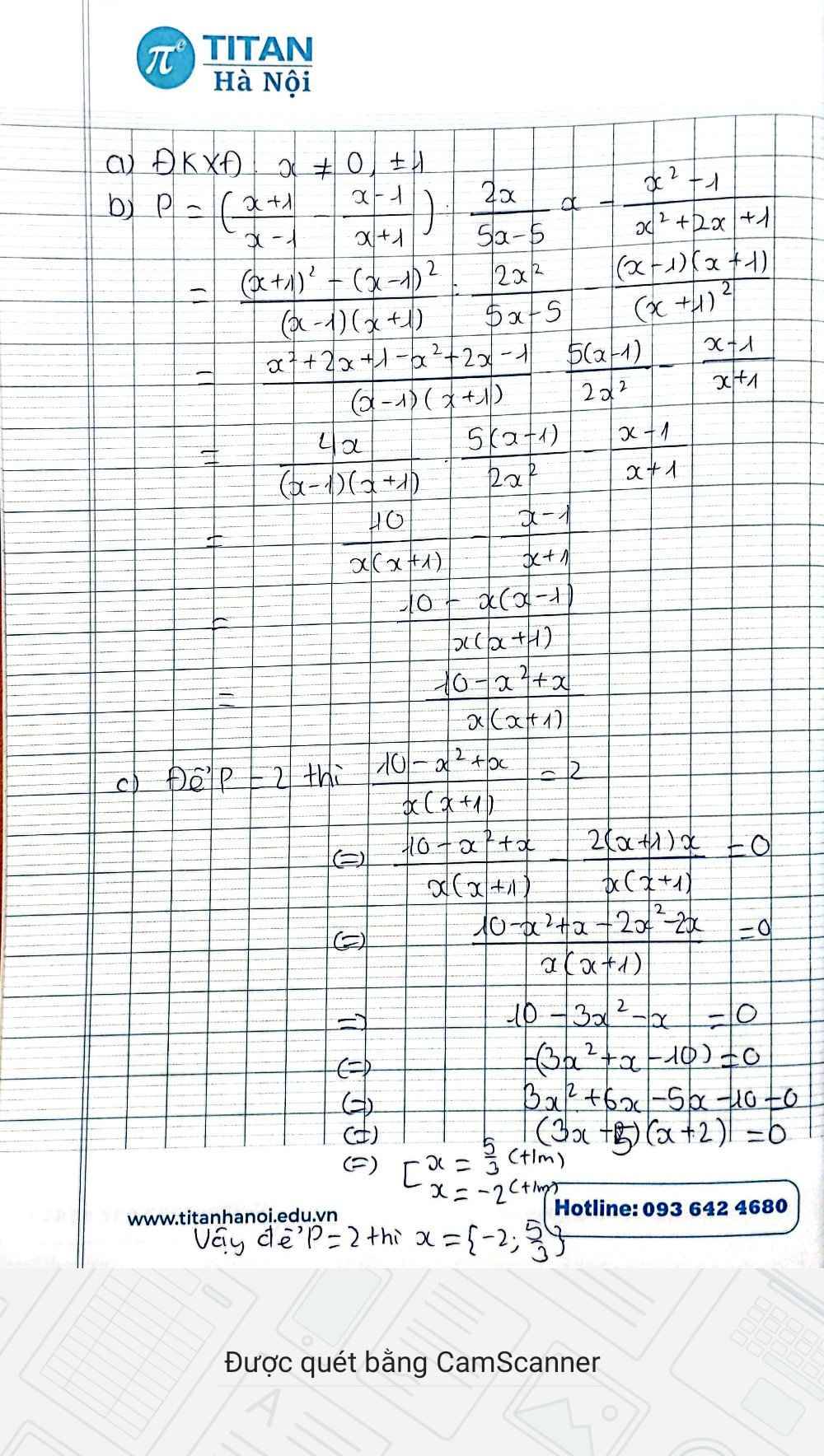Hãy nhập câu hỏi của bạn vào đây, nếu là tài khoản VIP, bạn sẽ được ưu tiên trả lời.

a) Ta có: \(P=\left(\dfrac{3}{x+1}+\dfrac{x-9}{x^2-1}+\dfrac{2}{1-x}\right):\dfrac{x-3}{x^2-1}\)
\(=\left(\dfrac{3\left(x-1\right)}{\left(x+1\right)\left(x-1\right)}+\dfrac{x-9}{\left(x+1\right)\left(x-1\right)}-\dfrac{2\left(x+1\right)}{\left(x-1\right)\left(x+1\right)}\right):\dfrac{x-3}{x^2-1}\)
\(=\dfrac{3x-3+x-9-2x-2}{\left(x-1\right)\left(x+1\right)}\cdot\dfrac{\left(x-1\right)\left(x+1\right)}{x-3}\)
\(=\dfrac{2x-14}{x-3}\)
b) Ta có: \(x^2-9=0\)
\(\Leftrightarrow\left(x-3\right)\left(x+3\right)=0\)
\(\Leftrightarrow\left[{}\begin{matrix}x-3=0\\x+3=0\end{matrix}\right.\Leftrightarrow\left[{}\begin{matrix}x=3\left(loại\right)\\x=-3\left(nhận\right)\end{matrix}\right.\)
Thay x=-3 vào biểu thức \(P=\dfrac{2x-14}{x-3}\), ta được:
\(P=\dfrac{2\cdot\left(-3\right)-14}{-3-3}=\dfrac{-20}{-6}=\dfrac{10}{3}\)
Vậy: Khi \(x^2-9=0\) thì \(P=\dfrac{10}{3}\)
c) Để P nguyên thì \(2x-14⋮x-3\)
\(\Leftrightarrow2x-6-8⋮x-3\)
mà \(2x-6⋮x-3\)
nên \(-8⋮x-3\)
\(\Leftrightarrow x-3\inƯ\left(-8\right)\)
\(\Leftrightarrow x-3\in\left\{1;-1;2;-2;4;-4;8;-8\right\}\)
\(\Leftrightarrow x\in\left\{4;2;5;1;7;-1;11;-5\right\}\)
Kết hợp ĐKXĐ, ta được: \(x\in\left\{4;2;5;7;11;-5\right\}\)
Vậy: Để P nguyên thì \(x\in\left\{4;2;5;7;11;-5\right\}\)

Câu 1:
1: Ta có: \(P=\left(\dfrac{x^2}{x^2-3}+\dfrac{2x^2-24}{x^4-9}\right)\cdot\dfrac{7}{x^2+8}\)
\(=\left(\dfrac{x^2\left(x^2+3\right)}{\left(x^2-3\right)\left(x^2+3\right)}+\dfrac{2x^2-24}{\left(x^2-3\right)\left(x^2+3\right)}\right)\cdot\dfrac{7}{x^2+8}\)
\(=\dfrac{x^4+3x^2+2x^2-24}{\left(x^2-3\right)\left(x^2+3\right)}\cdot\dfrac{7}{x^2+8}\)
\(=\dfrac{x^4+5x^2-24}{\left(x^2-3\right)\left(x^2+3\right)}\cdot\dfrac{7}{x^2+8}\)
\(=\dfrac{x^4+8x^2-3x^2-24}{\left(x^2-3\right)\left(x^2+3\right)}\cdot\dfrac{7}{x^2+8}\)
\(=\dfrac{x^2\left(x^2+8\right)-3\left(x^2+8\right)}{\left(x^2-3\right)\left(x^2+3\right)}\cdot\dfrac{7}{x^2+8}\)
\(=\dfrac{\left(x^2+8\right)\left(x^2-3\right)}{\left(x^2-3\right)\left(x^2+3\right)}\cdot\dfrac{7}{x^2+8}\)
\(=\dfrac{7}{x^2+3}\)
Câu 2a đề sai, pt này ko giải được
2b.
\(P\left(x\right)=\left(2x+7\right)\left(x^2-4x+4\right)+\left(a+20\right)x+\left(b-28\right)\)
Do \(\left(2x+7\right)\left(x^2-4x+4\right)⋮\left(x^2-4x+4\right)\)
\(\Rightarrow P\left(x\right)\) chia hết \(Q\left(x\right)\) khi \(\left(a+20\right)x+\left(b-28\right)\) chia hết \(x^2-4x+4\)
\(\Leftrightarrow\left\{{}\begin{matrix}a+20=0\\b-28=0\end{matrix}\right.\) \(\Rightarrow\left\{{}\begin{matrix}a=-20\\b=28\end{matrix}\right.\)
3a.
\(VT=\dfrac{1}{1+x^2}+\dfrac{1}{1+y^2}=\dfrac{2+x^2+y^2}{1+x^2+y^2+x^2y^2}=1+\dfrac{1-x^2y^2}{1+x^2+y^2+x^2y^2}\le1+\dfrac{1-x^2y^2}{1+2xy+x^2y^2}\)
\(VT\le1+\dfrac{\left(1-xy\right)\left(1+xy\right)}{\left(xy+1\right)^2}=1+\dfrac{1-xy}{1+xy}=\dfrac{2}{1+xy}\) (đpcm)
3b
Ta có: \(n^3-n=n\left(n-1\right)\left(n+1\right)\) là tích 3 số nguyên liên tiếp nên luôn chia hết cho 6
\(\Rightarrow n^3\) luôn đồng dư với n khi chia 6
\(\Rightarrow S\equiv2021^{2022}\left(mod6\right)\)
Mà \(2021\equiv1\left(mod6\right)\Rightarrow2021^{2020}\equiv1\left(mod6\right)\)
\(\Rightarrow2021^{2022}-1⋮6\)
\(\Rightarrow S-1⋮6\)

a,ĐK: \(\hept{\begin{cases}x\ne0\\x\ne\pm3\end{cases}}\)
b, \(A=\left(\frac{9}{x\left(x-3\right)\left(x+3\right)}+\frac{1}{x+3}\right):\left(\frac{x-3}{x\left(x+3\right)}-\frac{x}{3\left(x+3\right)}\right)\)
\(=\frac{9+x\left(x-3\right)}{x\left(x-3\right)\left(x+3\right)}:\frac{3\left(x-3\right)-x^2}{3x\left(x+3\right)}\)
\(=\frac{x^2-3x+9}{x\left(x-3\right)\left(x+3\right)}.\frac{3x\left(x+3\right)}{-x^2+3x-9}=\frac{-3}{x-3}\)
c, Với x = 4 thỏa mãn ĐKXĐ thì
\(A=\frac{-3}{4-3}=-3\)
d, \(A\in Z\Rightarrow-3⋮\left(x-3\right)\)
\(\Rightarrow x-3\inƯ\left(-3\right)=\left\{-3;-1;1;3\right\}\Rightarrow x\in\left\{0;2;4;6\right\}\)
Mà \(x\ne0\Rightarrow x\in\left\{2;4;6\right\}\)

a: \(A=\left(\dfrac{2x^2+2}{x^3-1}+\dfrac{x^2-x+1}{x^4+x^2+1}-\dfrac{x^2+3}{x^3-x^2+3x-3}\right):\dfrac{1}{x-1}\)
\(=\left(\dfrac{2x^2+2}{\left(x-1\right)\left(x^2+x+1\right)}+\dfrac{x^2-x+1}{x^4+2x^2+1-x^2}-\dfrac{x^2+3}{x^2\left(x-1\right)+3\left(x-1\right)}\right)\cdot\dfrac{x-1}{1}\)
\(=\left(\dfrac{2x^2+2}{\left(x-1\right)\left(x^2+x+1\right)}+\dfrac{\left(x^2-x+1\right)}{\left(x^2+1\right)^2-x^2}-\dfrac{x^2+3}{\left(x-1\right)\left(x^2+3\right)}\right)\cdot\dfrac{x-1}{1}\)
\(=\left(\dfrac{2x^2+3}{\left(x-1\right)\left(x^2+x+1\right)}+\dfrac{x^2-x+1}{\left(x^2+1+x\right)\left(x^2+1-x\right)}-\dfrac{1}{x-1}\right)\cdot\dfrac{x-1}{1}\)
\(=\left(\dfrac{2x^2+3}{\left(x-1\right)\left(x^2+x+1\right)}+\dfrac{1}{x^2+x+1}-\dfrac{1}{x-1}\right)\cdot\dfrac{x-1}{1}\)
\(=\dfrac{2x^2+3+x-1-x^2-x-1}{\left(x-1\right)\left(x^2+x+1\right)}\cdot\dfrac{x-1}{1}\)
\(=\dfrac{x^2+1}{x^2+x+1}\)
b: Để A là số nguyên thì \(x^2+1⋮x^2+x+1\)
=>\(x^2+x+1-x⋮x^2+x+1\)
=>\(x⋮x^2+x+1\)
=>\(x^2+x⋮x^2+x+1\)
=>\(x^2+x+1-1⋮x^2+x+1\)
=>\(-1⋮x^2+x+1\)
=>\(x^2+x+1\in\left\{1;-1\right\}\)
=>\(x^2+x+1=1\)
=>x2+x=0
=>x(x+1)=0
=>\(x\in\left\{0;-1\right\}\)

\(A=\frac{x}{x+1}-\frac{3-3x}{x^2-x+1}+\frac{x+4}{x^3+1}\)
\(A=\frac{x\left(x^2-x+1\right)}{\left(x+1\right)\left(x^2-x+1\right)}-\frac{3-3x}{\left(x+1\right)\left(x^2-x+1\right)}+\frac{x+4}{\left(x+1\right)\left(x^2-x+1\right)}\)
\(A=\frac{x^3-x^2+x-3-3x+x+4}{\left(x+1\right)\left(x^2-x+1\right)}\)
\(A=\frac{1}{\left(x+1\right)\left(x^2-x+1\right)}=\frac{1}{x^3+1}\)





câu a
\(\left(\dfrac{2x}{3x+1}-1\right):\left(1-\dfrac{8x^2}{9x^2-1}\right)\\ =\left(\dfrac{2x}{3x+1}-\dfrac{3x+1}{3x+1}\right):\left(\dfrac{9x^2-1}{9x^2-1}-\dfrac{8x^2}{9x^2-1}\right)\\ =\left(\dfrac{2x}{3x+1}-\dfrac{3x+1}{3x+1}\right):\left(\dfrac{9x^2-1}{\left(3x-1\right)\left(3x+1\right)}-\dfrac{8x^2}{\left(3x-1\right)\left(3x+1\right)}\right)\\ =\left(\dfrac{2x-3x-1}{3x+1}\right):\left(\dfrac{9x^2-1-8x^2}{\left(3x-1\right)\left(3x+1\right)}\right)\)
\(=\left(\dfrac{-x-1}{3x+1}\right):\left(\dfrac{x^2-1}{\left(3x-1\right)\left(3x+1\right)}\right)\\ =\dfrac{-x-1}{3x+1}\cdot\dfrac{\left(3x-1\right)\left(3x+1\right)}{x^2-1}\)
\(=\dfrac{-\left(x+1\right)\cdot\left(3x-1\right)\cdot\left(3x+1\right)}{\left(3x+1\right)\cdot\left(x-1\right)\cdot\left(x+1\right)}\\ =\dfrac{-3x+1}{x-1}\)
câu b
thay \(x=2\) vào P ta được
\(\dfrac{-3\cdot2+1}{2-1}=\dfrac{-6+1}{1}=-5\)
vậy \(P=5\) khi \(x=2\)